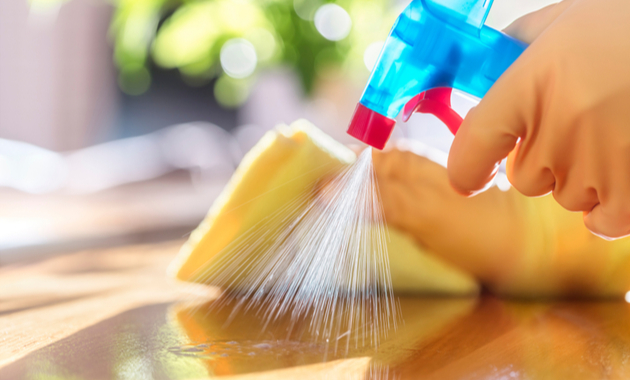
What is disinfection?
Various groups of microorganisms land on commonly touched surfaces like doorknobs, handles, lift buttons, desks, sink, etc. and can cause transmission of infections. These microorganisms are not visible to the naked eye and need to be killed.
Disinfection refers to a process of killing those microbes which may persist on such surfaces by using certain chemicals (EPA-approved disinfectants). This process might not clean dirty surfaces but by killing germs it reduces the risk of infection.
So, it is a good idea to keep your home and workplace clean and disinfected as it will reduce the likelihood of the microorganisms getting transferred from the commonly touched surfaces to your hands, and thereafter to your nose and respiratory system.
How does disinfection differ from cleaning?
Cleaning refers to the removal of any kind of impurities, dirt, debris, and stains from surfaces using a solution of detergent, water, and a clean cloth. It does not kill germs, but by lowering their number to a certain extent, it reduces the risk of spreading infection. For proper cleaning of surfaces, you must remove all visible matter by scrubbing the surface.
Is cleaning before disinfection important?
Yes, definitely. Effective cleaning is the first step to disinfect a surface. Once all visible matter has been removed, the next step is to disinfect the surface. This is because disinfectants cannot clean surfaces.
How to properly disinfect surfaces?
As mentioned above, the first step to effective disinfection is the proper cleaning of the surfaces.
(a) Steps in cleaning
– Wear disposable gloves to start the process.
– Clean surfaces using soap and water. Better use a scrubber for effective cleaning.
– Practice routine cleaning at home and disinfection may be required based on the level of use.
(b) Steps in disinfecting
– Buy pre-made commercial (only EPA-approved) disinfectants that state that they will kill 99.9% of microorganisms. These are available at most stores.
– Alternatively, you can also make your own disinfectant solution using chlorine bleach. Prior to handling chlorine bleach make sure you cover your skin and eyes (rubber gloves and safety glasses). Simply mix 50 parts water to 1 part 5% chlorine bleach. This mixture can be used if you do not have commercially available disinfectants and will properly disinfect most surfaces.
– Put the mixture in a clean and dry spray bottle.
– Cover your face and wear disposable gloves to protect your hands.
– Spray the disinfectant solution on the surface.
– Let it sit for approximately 10 minutes.
– Finally, wipe the solution off the surface using a clean dry cloth.
How effective is your disinfectant?
The effectiveness of a given disinfectant depends on various factors and one such factor is the contact time. Contact time is the duration for which the disinfectant must stay in contact with the surface until complete drying has occurred. Contact time varies for different disinfectants. It is advisable to use disinfectant products as per usage instructions given in the product label.
Which surfaces should you disinfect?
Any surface that comes into contact with various people throughout the day must be disinfected. As per the CDC, the commonly touched surfaces include:
– Tables
– Doorknobs
– Light switches
– Handles
– Desks
– Phones
– Keyboards
– Toilets
– Sinks
Do you need to disinfect your mobile and wallet?
Yes. For non-porous surfaces including electronics (e.g., mobile phones, tablets, touch screens) any solution containing more than 70% alcohol is recommended. You can use a soft cloth laden with an alcohol solution for disinfecting mobiles, mobile accessories, and wallets.
When disinfecting electronics, take care of the following:
– Avoid excessive wiping.
– Unplug all power sources, devices, and cables.
– Keep the alcohol-based liquids away from your device.
– Don’t allow moisture to get into any openings (of phone/tablet).
– Avoid spraying cleaners directly onto your device.
Disclaimer: This initiative, which is bought to you by 1mg Technologies Pvt. Ltd. (“1mg”) and Lizol, a trademark owned by Reckitt Benckiser Inc (“RB”) is for public awareness only. This should not be considered to be a medical advice and/or a substitute to a physician’s advice. The views and opinions expressed by the participating physicians are their independent professional judgement in collaboration with 1mg. RB does not claim any responsibility for the accuracy of their views. Please ensure that you consult your physician for further clarity.
References
1. CDC. Cleaning and Disinfection for Households. https://www.cdc.gov/coronavirus/2019-ncov/prepare/cleaning-disinfection.html?CDC_AA_refVal=https%3A%2F%2Fwww.cdc.gov%2Fcoronavirus%2F2019-
ncov%2Fcommunity%2Fhome%2Fcleaning-disinfection.html
2. RSPH. https://www.rsph.org.uk/uploads/assets/uploaded/942ce2bb-cdd0-41d4-9a3cdc84adb07aa6.pdf
3. CDC. Cleaning And Disinfecting Your Home. https://www.cdc.gov/coronavirus/2019-ncov/prevent-getting-sick/disinfecting-your-home.html
4. EPS. List N: Disinfectants for Use Against SARS-CoV-2 (COVID-19). https://www.epa.gov/pesticide-registration/list-n-disinfectants-use-against-sars-cov-2-covid-19
5. NPIC. Disinfectants and COVID-19. http://npic.orst.edu/ingred/ptype/amicrob/covid19.html
6. Penn Medicine. How to Clean and Disinfect Your Home Against COVID-19. https://www.pennmedicine.org/updates/blogs/health-and-wellness/2020/april/cleaning-against-covid
7. MoHFW. COVID-19: Guidelines on disinfection of common public places including offices. https://www.mohfw.gov.in/pdf/Guidelinesondisinfectionofcommonpublicplacesincludingoffices.
pdf